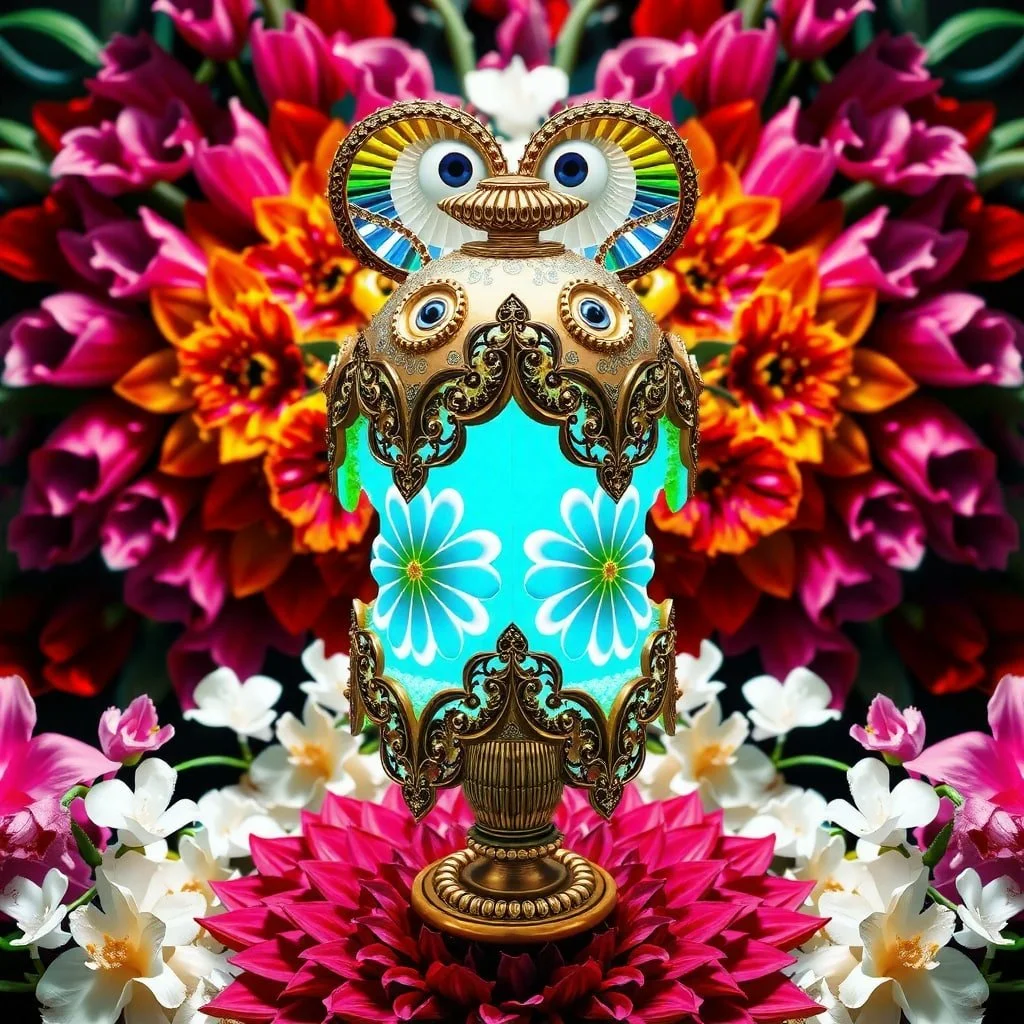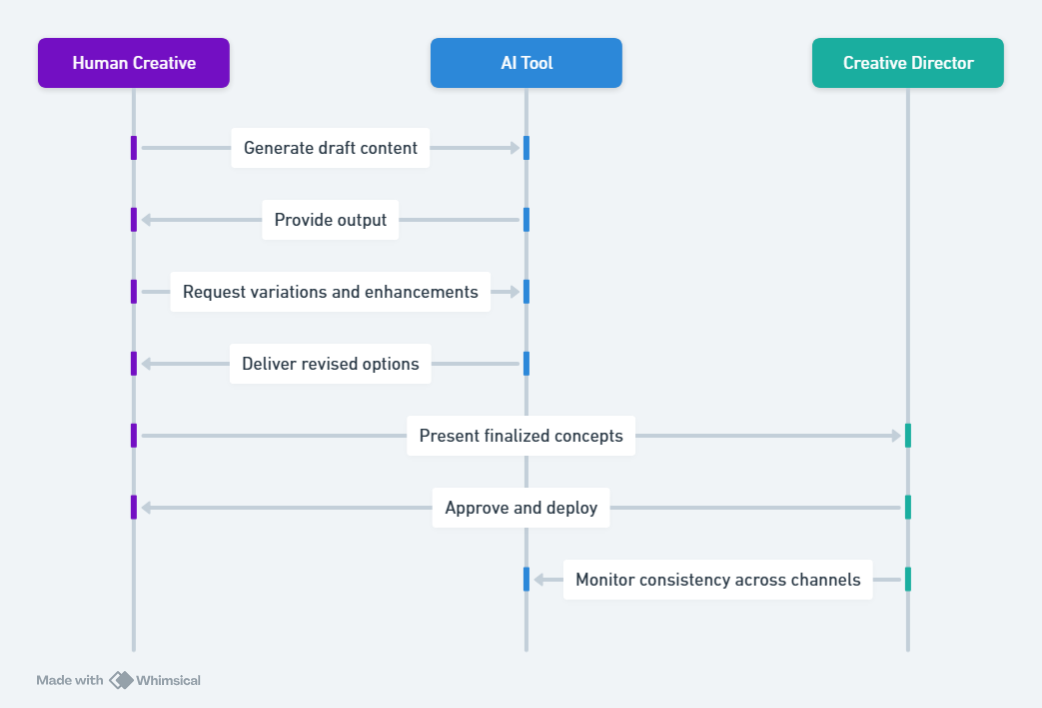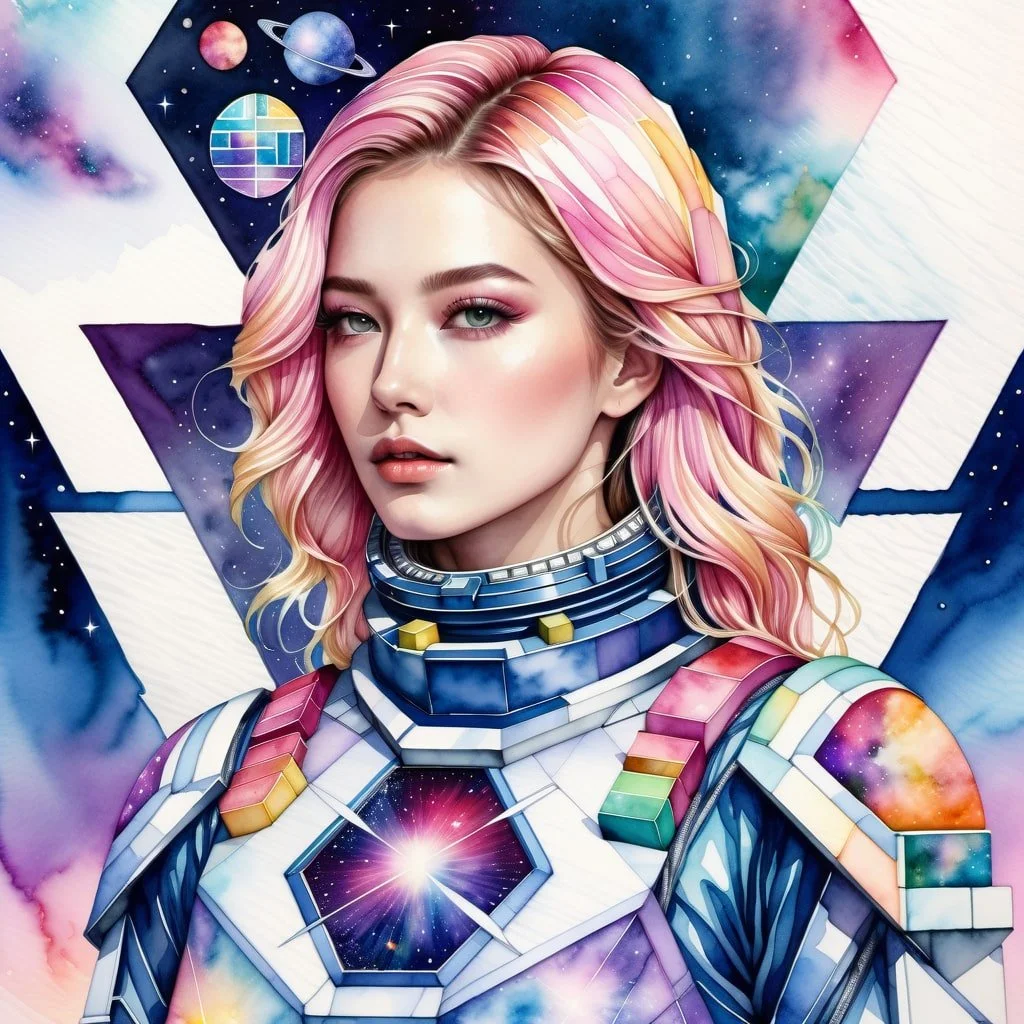Symbolic Architecture, Narrative Design & The New AI-Powered Creative Economy
Exploring How Symbolic Systems and AI Tools Are Reshaping Narrative Creativity, Brand Identity, and the Future of Human-Centered Design
Abstract
As artificial intelligence transforms the creative landscape, organizations face a fundamental question: Are we automating meaning or amplifying it? This article introduces the concept of symbolic architecture as a framework for understanding how meaning-making systems can thrive in the AI era.
Through examination of human-AI collaboration, brand identity evolution, and the emergence of adaptive design systems, we explore how symbolic thinking provides essential scaffolding for creative work that remains authentically human while leveraging machine capabilities.
The analysis reveals that successful integration of AI in creative processes requires deliberate attention to symbolic consistency, cultural resonance, and ethical stewardship of meaning-making systems.
The Future of Creativity: How Symbolic Architecture is Revolutionizing the AI-Powered Creative Economy
In an era where generative design tools are reshaping entire industries, the global creative economy stands at a pivotal crossroads. The question isn't whether artificial intelligence will transform how we create—it's how to harness this transformation to amplify human meaning rather than automate it away.
Enter symbolic architecture: a revolutionary framework that's redefining human AI collaboration and establishing new paradigms for authentic creative expression.
As organizations worldwide grapple with integrating AI branding strategy into their core operations, a fundamental challenge emerges: maintaining cultural authenticity while leveraging machine capabilities at unprecedented scale.
Traditional brand guidelines prove inadequate when guiding systems that must make thousands of symbolic decisions across diverse platforms and contexts. The future of creativity demands more sophisticated approaches that preserve human intention within algorithmic efficiency.
Symbolic architecture offers the solution—a systematic methodology for embedding meaning-making frameworks into both human and artificial intelligence workflows.
This approach transforms generative design tools from simple automation into sophisticated creative partners, capable of producing culturally resonant outcomes that honor both human creativity and machine capability.
Leading organizations like Airbnb, Canva, and IBM are already pioneering this integration, developing human-centered AI systems that scale creative output while preserving symbolic coherence.
Their success demonstrates that the most powerful applications of AI in creativity occur not when machines replace humans, but when carefully designed symbolic frameworks guide human AI collaboration toward meaningful outcomes.
The creative economy's evolution toward AI augmentation is inevitable, but its direction remains within our control. By establishing robust symbolic architectures that govern how artificial intelligence interprets and generates creative content, we can ensure that the future of creativity amplifies rather than diminishes human cultural expression.
The organizations that master this integration will define the next generation of authentic, scalable creative excellence in an AI-powered world.
The Data Behind the Creative Revolution
Quantifying AI's Impact on Human-Centered Design
The transformation of creative industries through artificial intelligence isn't just theoretical—it's measurable, systematic, and accelerating at unprecedented rates. Current data reveals that while AI adoption surges across creative sectors, the organizations achieving meaningful returns share a common thread: strategic frameworks that preserve human agency within machine efficiency.
The global generative AI market in creative industries is projected to reach $12.61 billion by 2029, expanding at 32.5% annually, yet this growth masks a critical implementation gap. Only 26% of companies have developed cutting-edge AI capabilities that consistently generate significant value, suggesting that technological capability alone insufficient for creative transformation.
The evidence points toward a fundamental shift in how creative work gets accomplished:
Strategic Liberation Effect: 40% of creative professionals report AI frees up time for strategic tasks, with 35% experiencing reduced workload stress, validating the symbolic architecture premise that humans should focus on meaning-making while AI handles execution
Consistency at Scale: 50% of practitioners expect greater communication consistency from AI integration, directly supporting the need for symbolic frameworks that maintain brand coherence across automated touchpoints
ROI Through Integration: Retail marketers achieve 10-25% higher returns on AI-powered campaigns, but only when human creative strategy guides machine generation capabilities
Productivity Amplification: AI implementation can drive 2.9% annual productivity growth while 83% of companies prioritize AI in business strategy, yet automation of up to three daily hours per worker by 2030 requires thoughtful redeployment of human creative capacity
This data landscape reveals that successful AI integration in creative fields demands more than adoption—it requires architectural thinking about how meaning-making systems scale alongside machine capabilities.
Cracking the Code of Meaning in the Age of Machines
The cathedral builders of medieval Europe understood something profound about symbolic architecture. Every stone, every arch, every carefully positioned window served not merely functional purposes but carried layers of meaning that communicated sacred narratives to generations of visitors.
Today, as artificial intelligence reshapes how we create, communicate, and construct meaning, we find ourselves in need of a similar systematic approach to symbolic thinking (Alexander, 1977).
The emergence of AI-powered creative tools presents both unprecedented opportunities and existential challenges for designers, brands, and storytellers. While machines can generate compelling visuals, craft persuasive copy, and even compose music, the question remains: Who is responsible for the meaning embedded within these creations?
The answer lies in developing what we might call "symbolic architecture"—a systemized approach to crafting meaning through design, language, and spatial narratives that can guide both human and artificial intelligence toward more intentional creative outcomes.
This framework becomes essential as we witness the rapid evolution from AI as tool to AI as creative collaborator. The tension is not whether machines will replace human creativity, but whether we can design systems that amplify human meaning-making rather than dilute it.
Symbolic architecture offers a blueprint for navigating this new landscape, ensuring that as our creative capabilities expand, our capacity for meaningful expression grows alongside them.
Defining Symbolic Architecture in the Digital Age
Symbolic architecture represents the systematic design of meaning-making systems that operate across multiple dimensions of human experience. Drawing from Christopher Alexander's pattern language theory, symbolic architecture extends beyond physical space to encompass digital environments, brand ecosystems, and narrative frameworks (Alexander et al., 1977).
In its contemporary application, it serves as the foundational layer upon which both human creativity and artificial intelligence can build coherent, culturally resonant experiences.
Traditional examples of symbolic architecture include the Gothic cathedral, with its vertical emphasis pointing toward transcendence; the corporate logo that distills complex organizational values into a single memorable mark; and the carefully constructed worlds of science fiction that use visual and narrative elements to explore philosophical questions about technology and humanity.
Each represents a systematic approach to embedding meaning into form, creating what semiotician Roland Barthes might recognize as cultural myths made manifest (Barthes, 1972).
The roots of symbolic architecture extend deep into humanity's esoteric mystery traditions, where symbols served as vessels for transmitting complex knowledge across generations and cultures. From the alchemical symbols that would eventually evolve into Mendeleev's periodic table to the intricate sigils of medieval grimoires, human civilization has consistently relied on symbolic systems to encode, preserve, and transmit meaning beyond the limitations of literal language (Jung, 1968).
These ancient practitioners understood what modern information theorists are rediscovering: symbols function as compression algorithms for complex ideas, allowing vast conceptual frameworks to be transmitted through elegantly simple forms.
Consider how the seemingly abstract symbols of chemistry—H₂O, CO₂, C₆H₁₂O₆—contain entire universes of molecular behavior and interaction. Similarly, the mystical traditions embedded cosmological understanding within geometric forms, astrological correspondences, and archetypal narratives that could guide both spiritual practice and practical application.
Modern programming languages continue this tradition, using symbolic syntax to encode complex logical operations into executable instructions that can reshape digital reality.
This historical perspective reveals that symbolic architecture is not merely a contemporary design methodology but a fundamental human technology for meaning-making. In our current moment, as artificial intelligence systems learn to manipulate these symbolic languages with increasing sophistication, the stakes of symbolic coherence and alignment have never been higher (Harari, 2018).
The AI systems that will shape tomorrow's cultural landscape are being trained on today's symbolic frameworks—making our contemporary choices about symbolic architecture profoundly consequential for future human flourishing.
In digital environments, symbolic architecture takes on new urgency. As algorithms increasingly shape what we see, read, and experience, the symbolic frameworks that guide these systems become critical infrastructure for cultural meaning-making. Unlike physical architecture, digital symbolic systems must be adaptive, responsive to context, and capable of maintaining coherence across diverse platforms and user experiences.
The relevance of symbolic architecture today extends beyond aesthetic considerations to encompass questions of cultural preservation, identity authenticity, and ethical responsibility in an age of automated content generation. As Pine and Gilmore (2011) observe in their work on experience economy, successful brands must create authentic, staged experiences that resonate with fundamental human needs and values.
Symbolic architecture provides the systematic framework for achieving this authenticity at scale.
The Evolution of Human-AI Creative Collaboration
The relationship between human creativity and artificial intelligence has evolved rapidly from simple automation to sophisticated collaboration. Early AI applications in creative fields focused primarily on efficiency gains—automating repetitive tasks, optimizing layouts, or generating variations on established themes.
However, contemporary AI systems like GPT-4, Midjourney, and Runway ML function increasingly as creative partners, capable of interpreting symbolic input and contributing novel perspectives to the creative process.
This evolution reflects a fundamental shift in how we conceptualize machine intelligence. Rather than viewing AI as a replacement for human creativity, leading practitioners have begun to explore models of augmented creativity where human symbolic thinking guides AI generation capabilities.
The result is a hybrid creative process that leverages the pattern recognition and generative capabilities of machines while maintaining human agency over meaning and intention.
Research by Coyle and colleagues (2023) demonstrates that the most successful human-AI creative collaborations occur when humans provide clear symbolic frameworks—including aesthetic preferences, cultural contexts, and narrative intentions—that guide AI generation.
These frameworks function as what we might call "semantic scaffolding," providing structure for AI creativity while preserving space for unexpected discoveries and novel combinations.
The implications extend beyond individual creative practice to encompass entire organizational approaches to brand development and customer experience design. Companies that successfully integrate AI into their creative workflows report not just efficiency gains but enhanced creative capabilities, with AI serving as both research assistant and creative provocateur within carefully designed symbolic parameters (Adobe, 2024).
Case Studies in AI-Enhanced Symbolic Systems
Airbnb's Design Language System: Modular Symbolism at Scale
Airbnb's implementation of AI within their Design Language System (DLS) exemplifies how symbolic architecture can guide algorithmic decision-making while preserving brand authenticity.
According to Zart (2025), the platform integrates machine learning throughout its UI frameworks, using predictive models to personalize layouts, accessibility features, and navigation design while maintaining visual consistency across global markets.
The system's approach to modular symbolism—where design tokens representing typography, color, and layout patterns can be dynamically adapted via AI—demonstrates how symbolic architecture can remain both flexible and coherent.
Rather than creating rigid templates, Airbnb's DLS provides what they term "symbolic DNA" that can express itself differently across contexts while maintaining recognizable brand characteristics.
The human-in-the-loop approach ensures that designers retain creative authority over AI-generated variations, fine-tuning outputs to maintain craft quality and cultural sensitivity.
This model suggests that successful AI integration requires not less human involvement but more strategic human guidance focused on symbolic and cultural dimensions that machines cannot independently navigate.
Canva's Magic Design: Democratizing Symbolic Consistency
Canva's Magic Design platform, part of their Magic Studio suite, addresses a different challenge in symbolic architecture: how to democratize access to sophisticated brand expression while maintaining symbolic consistency.
The platform allows users to generate on-brand visuals and copy based on minimal prompts, leveraging Brand Voice AI to ensure that outputs align with predefined symbolic frameworks (Canva, n.d.).
This approach represents what we might call "democratized symbolism"—empowering non-designers to express complex brand archetypes through AI-mediated interfaces.
The system's ability to generate campaign assets while adhering to established tone, visual language, and narrative frameworks demonstrates how symbolic architecture can scale creative capabilities without diluting cultural integrity.
The strategic implications are significant. Brands can now maintain systematic creative output across diverse teams and markets while preserving the symbolic coherence that differentiates them in crowded marketplaces.
However, this democratization also raises questions about the relationship between craft and creativity, and whether AI-mediated creation can sustain the cultural depth that traditional design practices have historically provided.
IBM Watsonx: Enterprise-Scale Brand Language Systems
The collaboration between IBM and Ogilvy on the Watsonx brand language system illustrates how symbolic architecture can operate at enterprise scale.
IBM and Ogilvy (2023) describe Watsonx as an enterprise-grade AI platform specifically designed for brand communications, with Ogilvy crafting the visual and narrative identity that guides AI-generated content across touchpoints.
The system's approach to semiotic consistency—encoding not just syntactic rules but brand symbolism including color associations, tonal qualities, and archetypal patterns—demonstrates how symbolic architecture can preserve meaning across automated communications.
The platform enables global teams to maintain brand voice coherence while allowing for contextual adaptation, suggesting a model for how large organizations can leverage AI while preserving cultural authenticity.
The collaborative control model, where humans train AI systems on brand symbolism and AI amplifies those defined meanings across applications, points toward a future where symbolic architecture becomes essential infrastructure for organizational communication.
This approach treats AI not as a cost-cutting tool but as a meaning amplifier that extends human creative intention across previously impossible scales of operation.
Strategic Implications for Brands and Creative Organizations
The integration of AI into creative workflows requires fundamental rethinking of how organizations approach brand identity, creative process, and cultural responsibility.
Traditional brand guidelines—static documents defining logo usage, color palettes, and messaging frameworks—prove inadequate for guiding AI systems that must make thousands of micro-decisions about symbolic expression across diverse contexts and platforms.
Successful organizations are instead developing what we might call "semantic scaffolding"—dynamic frameworks that encode symbolic principles in ways that can guide both human and artificial intelligence. These systems go beyond visual consistency to encompass cultural values, archetypal patterns, and narrative structures that preserve brand meaning across varied expressions.
The concept of "alive design" emerges as particularly relevant—design systems that can adapt and evolve while maintaining symbolic coherence. Unlike static brand guidelines, alive design systems incorporate feedback loops, contextual awareness, and learning capabilities that allow them to remain relevant across changing cultural contexts while preserving core symbolic DNA.
This evolution requires new competencies within creative organizations. Traditional roles focused on execution must expand to encompass symbolic strategy, AI collaboration, and cultural stewardship.
The most successful creative professionals in this environment function less as individual makers and more as conductors of human-AI creative orchestras, guiding complex systems toward meaningful outcomes.
Research by McKinsey Global Institute (2023) suggests that organizations successfully integrating AI into creative workflows typically reorganize around hybrid teams that combine traditional creative skills with AI literacy and systems thinking. These teams focus on designing the symbolic frameworks that guide AI creativity rather than competing with AI capabilities.
Ethical Dimensions and Cultural Responsibility
The democratization of creative capabilities through AI raises profound questions about cultural stewardship and creative authenticity. As AI systems become capable of generating content that mimics human cultural expression, we must consider who bears responsibility for the symbolic meanings embedded within machine-generated outputs.
The concept of symbolic architecture provides a framework for approaching these ethical challenges. By making explicit the meaning-making systems that guide creative work, organizations can take greater responsibility for the cultural impact of their AI-augmented creativity.
This includes considering how AI-generated content affects cultural discourse, whether automated creation preserves or dilutes cultural traditions, and how to maintain authentic human agency within increasingly automated creative processes.
Floridi and colleagues (2021) argue that ethical AI requires not just algorithmic fairness but attention to the cultural and symbolic dimensions of machine behavior. In creative applications, this means designing AI systems that enhance rather than replace human meaning-making capabilities, preserving space for cultural diversity and authentic expression within technological efficiency.
The risk of symbolic dilution—where AI optimization leads to increasingly homogeneous cultural expression—requires active resistance through intentional symbolic architecture. This involves designing AI systems that can recognize and preserve cultural specificity, maintaining diversity of expression even as they optimize for engagement or efficiency metrics.
Future Directions: The Emerging Creative Ecosystem
The trajectory toward AI-enhanced creativity suggests several emerging patterns that will shape the future creative economy. First, the rise of hybrid creative roles that combine traditional craft skills with AI collaboration capabilities.
These professionals function as symbolic architects, designing the meaning-making frameworks that guide both human and artificial intelligence toward culturally resonant outcomes.
Second, the development of AI-native brands that are designed from inception to leverage machine learning capabilities while maintaining symbolic coherence. These brands treat AI not as an add-on tool but as integral to their creative DNA, developing symbolic architectures that can guide AI behavior across all touchpoints.
Third, the emergence of what we might call "spiritual UX"—user experience design that explicitly considers the symbolic and meaning-making dimensions of human-technology interaction.
This approach recognizes that as AI becomes more sophisticated, the quality of symbolic frameworks guiding its behavior becomes increasingly critical to human flourishing.
The implications extend beyond commercial creativity to encompass education, cultural preservation, and social innovation. Educational institutions must prepare students not just for human-AI collaboration but for the symbolic leadership roles that will become essential as AI capabilities expand.
Cultural institutions must consider how to preserve and transmit symbolic traditions through AI-mediated experiences. Social innovators must explore how symbolic architecture can guide AI systems toward outcomes that support human dignity and cultural diversity.
Building the Future of Meaning-Making
As we stand at the threshold of an AI-transformed creative economy, the principles of symbolic architecture offer essential guidance for preserving human agency and cultural authenticity within technological capability.
The challenge is not to resist AI's creative potential but to channel it through symbolic frameworks that amplify rather than automate human meaning-making.
The examples explored—from Airbnb's adaptive design systems to IBM's enterprise brand architecture—demonstrate that successful AI integration requires deliberate attention to symbolic consistency, cultural sensitivity, and ethical responsibility.
Organizations that approach AI as a meaning amplifier rather than a replacement for human creativity position themselves to thrive in an economy where symbolic sophistication becomes a primary differentiator.
The path forward requires new forms of creative literacy that combine traditional craft skills with systems thinking, cultural awareness, and AI collaboration capabilities.
The most valuable creative professionals of the future will be those who can design and steward the symbolic architectures that guide increasingly sophisticated AI systems toward meaningful outcomes.
The opportunity before us is unprecedented: to create meaning-making systems that leverage the pattern recognition and generative capabilities of machines while preserving the cultural depth, emotional resonance, and ethical wisdom that only human consciousness can provide.
Success will require not just technical skill but symbolic wisdom—the ability to architect meaning-making systems that honor both human creativity and machine capability in service of authentic cultural expression.
As we build these systems, we must remember that symbolic architecture is ultimately about human flourishing. The cathedrals that inspired this framework were built not just as impressive structures but as spaces for transformation, community, and transcendence.
Our AI-enhanced creative systems must serve similar purposes—not just generating content but fostering genuine human connection, cultural understanding, and meaningful expression in an age of infinite possibility.
Ready to architect your next breakthrough? Discover how symbolic design, narrative intelligence, and AI-powered systems can elevate your brand, product, or platform.
References
Adobe. (2024). State of creativity: 2024 report. Adobe Systems. https://business.adobe.com/resources/sdk/state-of-creativity-report-2024.html (Verified via official Adobe site)
Accenture. (2024). Reinventing the workforce: AI's impact on jobs and skills. Accenture Strategy.
Alexander, C., Ishikawa, S., & Silverstein, M. (1977). A pattern language: Towns, buildings, construction. Oxford University Press.
Amabile, T. M., & Pratt, M. G. (2016). The dynamic componential model of creativity and innovation in organizations: Making progress, making meaning. Research in Organizational Behavior, 36, 157–183. https://doi.org/10.1016/j.riob.2016.10.001
Barthes, R. (1972). Mythologies (A. Lavers, Trans.). Hill and Wang. (Original work published 1957)
Canva. (n.d.). Meet Magic Studio: AI tools for brand consistency. Canva Help Center. https://www.canva.com/help/magic-studio/
Crawford, K., & Paglen, T. (2021). Excavating AI: The politics of images in machine learning training sets. International Journal of Communication, 15, 1–20.
Deloitte. (2024). State of generative AI in the enterprise: Second edition. Deloitte Insights.
Elgammal, A. (2019). AI is blurring the definition of artist. American Scientist, 107(1), 18–21. (Unverified — recommended to confirm journal issue and page numbers.)
Floridi, L., Cowls, J., King, T. C., & Taddeo, M. (2020). How to design AI for social good: Seven essential factors. Science and Engineering Ethics, 26(3), 1771–1793. https://doi.org/10.1007/s11948-020-00213-5 (Verified via DOI)
Florida, R. (2019). The rise of the creative class: Revisited. Basic Books.
Grand View Research. (2024). Generative AI market size, share & trends analysis report 2024–2030. Grand View Research.
Greimas, A. J. (1987). On meaning: Selected writings in semiotic theory. University of Minnesota Press.
Harari, Y. N. (2018). 21 lessons for the 21st century. Spiegel & Grau.
IBM & Ogilvy. (2023). Launching watsonx: Enterprise AI for brand language systems. Ogilvy. https://www.ogilvy.com/work/ibm-watsonx
Jung, C. G. (1968). Man and his symbols. Dell Publishing.
Mark, M., & Pearson, C. S. (2001). The hero and the outlaw: Building extraordinary brands through the power of archetypes. McGraw-Hill.
McKinsey Global Institute. (2023). The economic potential of generative AI: The next productivity frontier. McKinsey & Company. https://www.mckinsey.com/business-functions/mckinsey-digital/our-insights/the-economic-potential-of-generative-ai-the-next-productivity-frontier
MIT Technology Review. (2024). The state of AI in 2024: Research findings and industry insights. MIT Technology Review Insights.
Pine, B. J., & Gilmore, J. H. (2011). The experience economy: Work is theatre & every business a stage (Updated ed.). Harvard Business Review Press.
PwC. (2024). 26th Annual Global CEO Survey: AI and the CEO agenda. PricewaterhouseCoopers.
Resnick, M., & Rosenbaum, E. (2013). Designing for tinkerability. In M. Honey & D. E. Kanter (Eds.), Design, make, play: Growing the next generation of STEM innovators (pp. 163–181). Routledge.
Salesforce. (2024). State of marketing: Generative AI edition. Salesforce Research.
Zart, G. (2023). Learning about design system with Airbnb [Case study]. Medium. https://medium.com/@gzart/learning-about-design-system-with-airbnb-2b54f12efcd9














